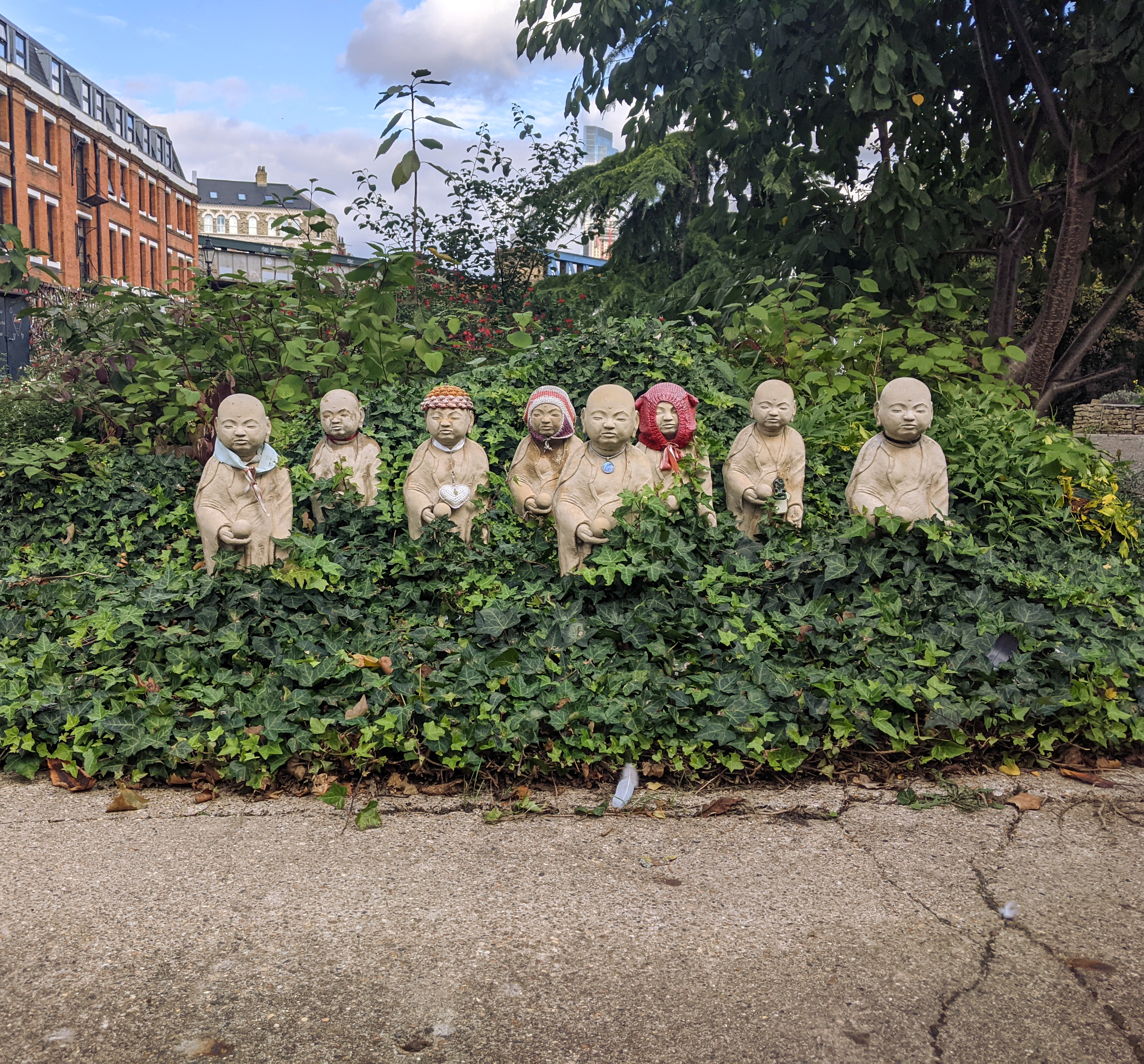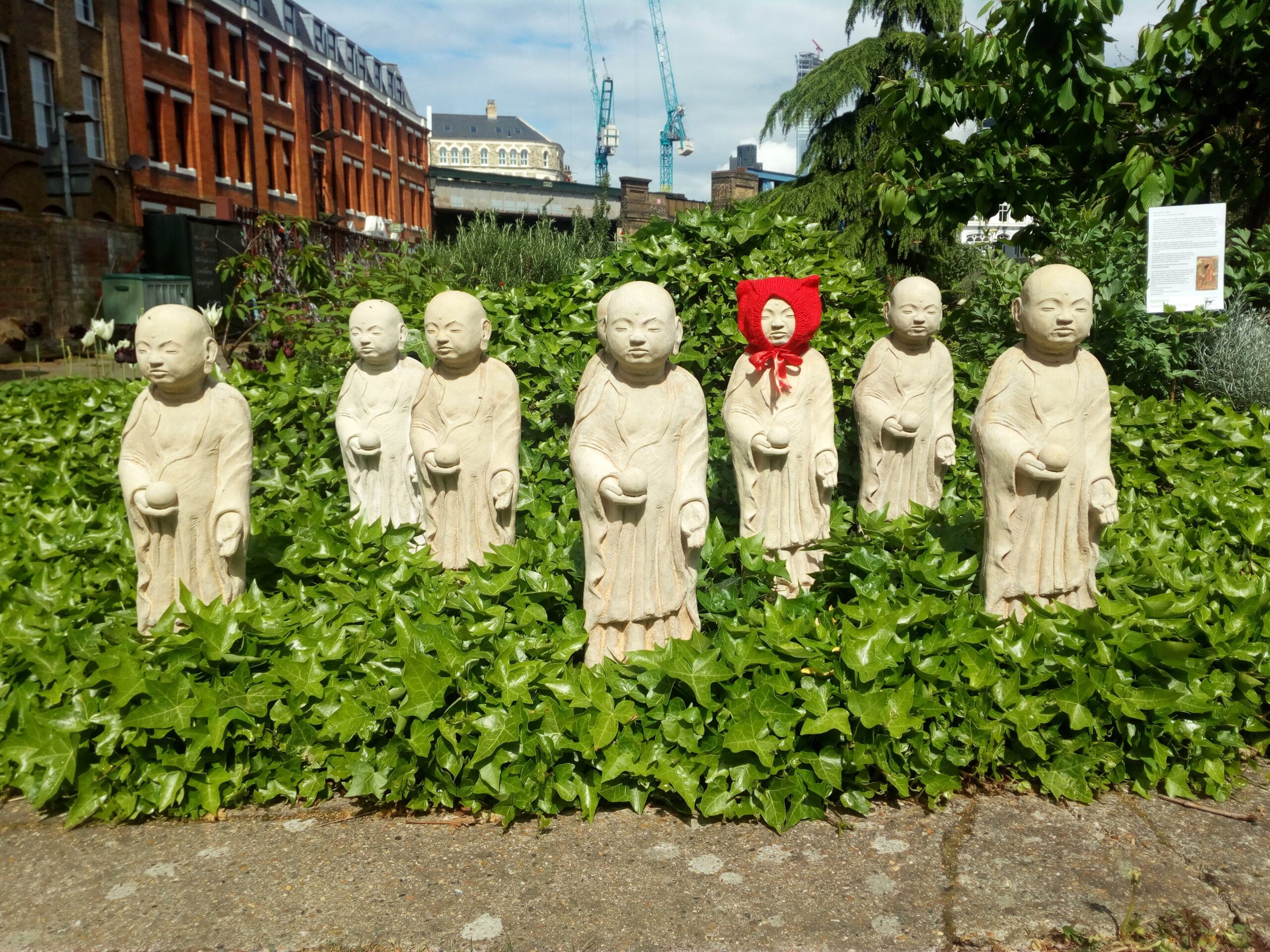At the southern end of Crossbones Graveyard, a group of stone statues stand with their backs to the City, facing the old cemetery wall. Each statue is about as tall as a toddler, wearing a serene resting expression. The stone folds of their monk’s robes ripple downwards into the sea of ivy they seem to be emerging from. Some of the statues – known as Mizuko Jizōs – wear hand-crotched red bonnets, some fading with the weather, some fresh and bold, while others wear pendants and sashes inked with felt-tipped epitaphs.
‘Mizuko (水子)’ translates to ‘water-child’: etymologically referring to unborn children who never made it out of the ‘watery world’ from which all life originates in the Japanese tradition. Mizuko is also used to refer to children who died while very young, ‘whose hold on life in the human realm is still tenuous,’ [1] and more expansively, ‘any child who died prematurely and disrupted the natural order of things by leaving this world before his or her parents.’ [2] ‘Jizō (地蔵)’ – translating as ‘earth-store’ – is a Japanese Buddhist bodhisattva deity, refusing to reach Nirvana until all the earthly ones are enlightened. Neither male nor female, [3] Jizō is associated with the liminal space between the living and the dead, and has thus become a prominent figure for those mourning babies and fetuses that were stillborn, miscarried, or aborted.
The association between Jizō and the water-children can be traced back to the female oracles, mediums, fortune-tellers, and ritual performers who developed the idea of a riparian, liminal space as a place where the ‘unconnected’ water-children were condemned to go. The story they told was of these water-children piling up stones on the water’s edge in order to make amends for the suffering they had caused their parents. [4] Jizō was present in these stories, comforting the children caught up in the tides of the watery world, and as a mediator between the child and their parents. This attribution of blame to the water-children stands in stark contrast against contemporary Western attitudes around child death and miscarriage. It is not surprising, therefore, that the contemporary ceremony of Mizuko Kuyō, which explicitly calls on Jizo to alleviate the pain of babies and fetuses’ transition through it, has often taken on a very different tone, particularly outside of the Japanese context. The ceremony is often held today with the purpose of ameliorating pain for all involved. Nonetheless, it remains woven through with complex histories and their implications.

The rise of Mizuko Kuyō since the 1970s has been propelled by a context in which Western notions of life and death as individually-bounded have gradually inflected Japanese perspectives. This shift has been accelerated by post-war technologies that allow fetuses to be seen and therefore apprehended as alive, and as individual, in ways that they were previously not. These changing perspectives have exacerbated feelings of shame and guilt around abortion and miscarriage for Japanese women, [5] aligning with political circumstances that precipitated a significant rise in the number of women having abortions in the post-war period. In Japan’s state of post-war economic ruination, eugenics policies were put in place that encouraged poor families to have abortions. A need thus developed for women to grapple with the difficult feelings this threw up, and Mizuko Kuyō ceremonies became a way of meeting this need. This need has, at times, been exploited by opportunists for financial gain, leading to the Mizuko Kuyō ceremony being considered somewhat controversial within Japanese Buddhism.[6]
The consequences of opportunistic instrumentalization of Mizuko Kuyō ceremonies disproportionately affect women, whose perceived or imposed guilt is the main target of exploitation. Such exploitation has often taken the form of the threat of a curse, the fear of which is often bound up with hope for a concrete benefit and the intent to remember the child or fetus. [7] While in Japan Mizuko Kuyō ceremonies are nearly always held for women, restrictive Japanese abortion laws still in place today mandate that married women must obtain their husband’s written consent to end a pregnancy. Despite a legal framework that restricts women’s rights in the guise of a shared responsibility, the burden of guilt and repentance is placed squarely on the shoulders of women.

As Mizuko Kuyō has gradually become adopted in the West, its scope and possible meanings have expanded. The ceremony has offered a way for people affected by child death or abortion to acknowledge and honour what they are feeling; and crucially, offers a setting in which these feelings are witnessed by others in community, in contexts where there is no cultural precedent for this. However, Mizuko Kuyō has also been appropriated in the West (and particularly in the U.S.A.) in the hotly contentious debates between anti-abortion and pro-choice movements. Organisations associated with these movements have played a key role in disseminating information about Mizuko Kuyō to non-Buddhist Americans, and have selectively emphasised and popularised dimensions of the ceremony according to their political position. [8] While anti-abortion movements have mobilised Mizuko Kuyō to argue that abortion is inherently morally wrong and will therefore inevitably result in guilt and trauma for those involved, pro-choice movements have emphasised the community witnessing element of Mizuko Kuyō as a means of reducing stigma around abortion.
The context around the introduction of the Jizōs to Crossbones testifies to this urgent need for community witnessing around child death, miscarriage and abortion. Grief and other feelings around these issues are not given the collective emotional, social nor physical space necessary for those affected to process them, in part due to their being considered taboo, or perhaps simply ‘too difficult.’ This lack of acknowledgement and memorialisation leaves a crucial emotional, social and spiritual need unmet, which Mizuko Kuyō, when sensitively introduced, can go some way to filling. The process of introducing Jizōs to Crossbones began in 2017, when BOST, who manage Crossbones, were approached by several parents who had experienced the death of a child. Moved by the high proportion of child burials recorded at Crossbones by Museum of London Archaeology,[9] they asked whether an area of the site could be dedicated to honour children specifically. It was suggested that Mizuko Kuyō practices offered a model for how this area might be treated and BOST then commissioned a local stoneworker, Josh Locksmith, to create a set of Jizō statues which were inaugurated with a small ceremony.

This organic and dialogical process, emerging from (under) the ground up, shows us the best of Mizuko Kuyō: a receptive and compassionate response to an identified need. This ethical engagement is a continuation of the practices of that have been gradually sedimented into the Garden of Remembrance itself: unlike a typical memorial ‘set in stone,’ Crossbones is rich with tangible provocations to respond to it. As visitors find painted stones nestled underneath plants, ribbons tied for recently deceased loved ones on the gates, and names inked on bare wood at the suicide shrine, they are met with the invitation not simply to observe but to participate. The parents who approached BOST with a view to honouring child death took up this invitation as an opportunity to carve out a physical space to process a specific and underacknowledged grief.
Like the permeable drystone walls that were built at Crossbones to instil a sense of speculative longevity, the stone Jizō statues mark the passage of time as they are touched by the world they inhabit, in a way that is visible to our human eyes over a relatively short period. They ‘settle in’ as smog-tinged rain runs over them, as microbial and vegetal life finds a foothold in its porous surfaces, as birds that perch on them and leave their droppings behind. Human visitors to the site further help the Jizōs settle in as they adorn the statues with offerings, which age along with the Jizōs, polyrhythmically sounding out the marks of time. The hope is that as people spend a few moments with the Jizōs and give something away to them, they can give something of their suffering away as well.
[1] Bays, J.C., 2015. Jizo Bodhisattva: Modern Healing & Traditional Buddhist Practice. Tuttle Publishing, p. 62.
[2] Moto-Sanchez, M.M., 2016. Jizō, healing rituals, and women in Japan. Japanese Journal of Religious Studies 43, p. 317.
[3] Bays, p.21.
[4] Moto-Sanchez, p. 316.
[5] Bays, pp. 62-67.
[6] Bays, p. 67.
[7] Komatsu, K., 2003. Mizuko Kuyō and new age concepts of reincarnation. Japanese Journal of Religious Studies 30, p. 262.
[8] Wilson, J., 2009. Mizuko kuyō in the abortion cultural wars: The rhetorical appropriation of Japanese Buddhism by non-Buddhist Americans. Religion 39, 11–21.
[9] Brickley, M., Miles, A., Stainer, H., 1999. The Cross Bones burial ground, Redcross Way Southwark, London: archaeological excavations (1991-1998) for the London Underground Limited Jubilee Line Extension Project, MoLAS monograph. Museum of London Archaeology Service and Jubilee Line Extension Project, London. pp. 25, 31.

One response to “Mizuko Jizō”
Wonderful information. I lost a child due to miscarriage when I was young. I find it comforting to know that the Mizuko Jizō are there to watch over and protect the little “water babies”.